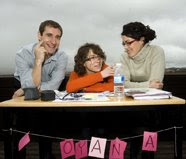
yesterday i finished reading this clarifying book.
i must say it started very exciting but finished rather heavy; perhaps, more than as a must-read book, i'll define it as a must-be-on-the-shelf book.
some remarcable pages:
[48]
"Summary of emerging principles to guide activities into the 21st century:
- respect for life and intrinsic right of all species to exist now and in the future.
- first do no harm.
- waste no want not.
- efficient use of energy and resources.
- we reap what we sow (we are responsible)
- learn from nature: design for sustainability.
- clean up after yourself.
- achieve radical resource productivity - beyond factor 10.
- develop close loop and zero waste systems.
- ensure non-toxic products and production.
- economy based on renewable resources.
- protect and enhance a rich biodiversity.
- reduce major risks."
"Allars characterist of effective voluntary agreements:
confining-structuring-checking."
it shows very interesting indicators and best cases of governance (sorry, i couldnt find a link in the web)
[278]
"old style development is characterized by language such as:
balance-limited impact-competition-acceptable levels of-meeting all statutory requirements-consultation-experts-planning-no major effects-you cant have development without-financial benefit-im only the-its not my responisibility-in the ideal world, but-...
sustainability is characterized by language such as:
net benefit-change-ongoing management-efficiency-inclusive-innovation-design-best practice-long term-participation-engagement-altruism-repair-enhance-sense of place-sacred-economic performance-externalities-broad based benefit-partnership-network-..."
[310]
"design principles for Goa 2100 :
A Dynamic Fractal Morphology:
- Cellular structure: nuclei, cores, spines and skins
- Hierarchical networks adapting to topography
- Optimal densities, settlement structure and heights enabling security
- Contiguous and hyperlinked with interpenetration of living nets
- Dynamic consolidation and nucleation around fractal boundaries and surfaces.
- Well-being of all people, communities and ecosystems (Sufficiency and Equity),
- using a minimal throughput of matter-energy-information (Efficiency),
- with least impact on nature, society and future generations (Sustainability)
- Satisfying the basic human needs of all people and providing them an equal opportunity to realize their humanpotential.
- Material needs should be met materially and nonmaterial needs non-materially.
- Renewable resources should not be used faster thantheir regeneration rates.
- Non-renewable resources should not be used fasterthan their substitution rates by renewable resources
- Pollution and waste should not be produced faster than the rate of absorption, recycling or transformation
- The Precautionary principle should be applied where the ‘response’ time is potentially less than the ‘respite’time
- ‘Free-energy’ and resources should be available to enable redundancy, resilience and reproduction
- Enable a long-term ecological transition from forest >> cropland >> city >> forest
- Design the landscape first; situate the city in the interstitial niches
- Land-use transition ‘rules’ governed by the demandfor ecosystem services, resource potential, natural ecological succession and contiguity
- Identify static and dynamic elements in the city,design the former, and provide a dynamic vocabulary forthe latter to co-evolve with the landscape
- Devolve governance and taxation to the lowest viable level
- Use less with Factor 4 technologies for supply and social limits of sufficiency and equity on demand
- Grow your own, tapping harvestable yields as autonomously as possible
- Build two-way networks for security; every consumer is also a producer
- Store a lot because renewable resource yields are often diurnal and seasonal
- Transport less and over shorter distances using least life-cycle cost technologies
- E-change using intelligent wireless networks to enable real-time trade and delivery of goods
[449]
"the ISIS method:
Indicators-Systems-Innovation-Strategy,
in conjunction with the compass of sustainability (see pic above) and the Pyramid planning framework."
IR and IU have a copy at their desk.



No hay comentarios:
Publicar un comentario